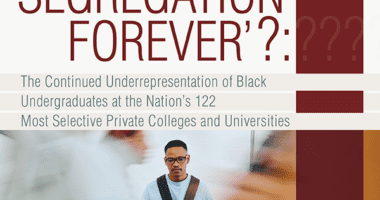#EdTrust2014 Conference — Day Two
If you’re looking for information from Day One, click here.
FINAL UPDATE 2:10 p.m.
Heard Around Conference
Degrees of Preparation: Ensuring students have the classroom-ready teachers they need
In Tennessee and Delaware, state departments of education are working toward stronger accountability systems for their teacher preparation programs. This includes rating training programs on outcomes, like graduation, Praxis pass rates, job placement, and retention.
A conference attendee asked, What have you seen are the critical parts of these programs that are making a difference for teachers and students?
Delaware hasn’t been collecting data long enough to say, but Tennessee has been collecting data for six years — including the academic performance of students who are taught by graduates of teacher prep programs. Through that, they have found a couple of common themes among their most successful training programs: a very engaged clinical experience, high standards, and mentor teachers who have strong education background. But Victoria Harpool, First to the Top program coordinator at the Tennessee Higher Education Commission, warned that there is no single answer or solution. Different strategies have worked for different programs.
“My answer is very frustrating,” Harpool admitted. “There are no silver bullets … because, boy, we’d have loved to find that.”
UPDATED 2 p.m.
Restoring Justice, Igniting Change: Youth and allies at the frontlines of the fight for school discipline reform
In our final plenary session, the DC Youth Slam Team got a standing ovation for its performance. Flip through the photos below or click on the title to see the full Storify. Afterward, leaders and allies of Padres y Jóvenes Unidos carried that enthusiasm and energy into a discussion of their efforts to fight inequities in school discipline.
UPDATED 12:20 p.m.
College Counseling: From restricted access to all-access
Nina Marks spent years counseling affluent students in the D.C. area, witnessing firsthand how sustained support made a big difference in ensuring those students’ college success. Nine years ago, she took that knowledge and founded Collegiate Directions, Inc., a nonprofit dedicated to helping low-income and first-generation students get to and through college.
Too often children are handed off like batons on the relay field,” said Marks, who along with CDI president Rachel Mazyck, shared how they work specifically to make sure that doesn’t happen to the students they work with.
Among the many successful college advising strategies they shared is to first help students find a good college match. “It’s not just about academics,” said Mazyck. “Students need to find a college that fits them social and financially as well. … With a good match and appropriate supports, students are better prepared to succeed.”
They also encourage students to apply to eight to 10 colleges in three categories: safety (a student has a 75 percent or higher chance of being admitted); possible (a student has 50/50 chance of being admitted); and reach (a student has up to a 25 percent chance of being admitted).
Mazyck pointed conference participants to a number of useful resources they can use when helping students and families come up with a college list. One of those is EdTrust’s own collegeresults.org, which now includes a feature that flags colleges that have low graduation rates or low numbers of Pell-eligible students. That’s good information for families, students, and counselors to know, said Mazyck.
“Good advising can be life-changing. For average students too, not just for academic superstars,” said Marks. “Great advising is not a luxury; it is a necessity.” For more about how Collegiate Directions, Inc. works to address college-going inequities, visitwww.collegiatedirections.org.
– Robin Harris Smiles
UPDATED 11:35 a.m.
Translating the Core: Implementing Common Core for English Language Learners
Teachers might often hear their students say, “I’m not a math person.” But at Laurel Street Elementary School, a high-poverty, predominantly Latino school in Compton, Calif., teachers say that students are more likely to say “I’m not an English person.”
That’s because many of their students are English learners. For them, English is more difficult than math. And now, with the transition to the Common Core, that challenge is more intense.Math standards under the Common Core require students to articulate their thinking and explain mathematical processes, more so than under previous standards.That presents an additional challenge for Laurel Street’s students, who may understand the mathematical concepts but can’t communicate them.
To adjust, the teaching staff at Laurel Street — a 2012 Dispelling the Myth Award winner — spend a lot of time modeling for students. Every classroom, regardless of subject, uses sentence frames. These are beginning or transitional phrases aimed at helping students communicate more fluidly and naturally — “In my opinion …” or “I think my answer is correct because …”
After teachers model how they’re used, students practice together in pairs or small groups before they’re called on in class. This creates the confidence they need to be more comfortable using a language that isn’t native to them, says teacher Angel Chavarín. “English learners have to see it and hear it over and over again,” he said. “This is how they grasp the ideas and the language.”
Beyond stringing thoughts and sentences together, teachers also walk through math processes in explicit detail, mindful of explaining each step. Under the Common Core, students are expected not only to complete a math problem, but also to explain how. This has meant more classroom time for step-by-step instructions, as well as extended opportunities for error analysis — or where things go wrong.
“I have to make my thinking process visible for my students,” says Alejandra Monroy, literacy coach. “Transferring the learning from the teacher to the student has to be progressive.”
After the teacher models it, students practice working through problems with each other, explaining the steps in their own words (and with sentence frames!). Laurel Street teachers admit that it can get a little loud during this pair work, but it’s what they affectionately call “productive noise.”
UPDATED 9 a.m.
Accentuating the Positive: Policies and practices that promote black and Latino male student achievement
Shaun Harper, executive director of the Center for the Study of Race and Equity in Education, spoke about how the negative statistics and attention around the achievement of black and Latino boy sets a negative tone and creates a culture of low expectations. Rather than focusing on the black and Latino boys who don’t graduate, for example, we should focus on those who do — and learn from them.
POSTED 7:35 a.m.
Welcome to Day Two!
Welcome to day two of Ed Trust’s 2014 National Conference. Like yesterday, we’ll be blogging here throughout the day, sharing some of the stories and information presented during our plenaries and breakout sessions. If you’re here with us, this will be a good spot to check back for sessions you may have missed (there’s a lot to choose from, we know!). You can also share your own experiences below in the comments. If you’re at work or home, we hope these snippets capture enough for you to feel a part of conference.
Stay tuned!









